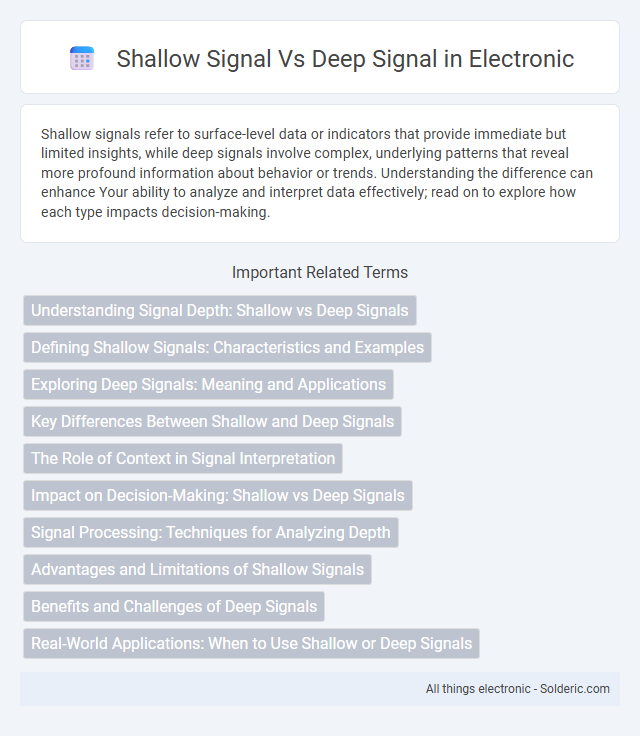Shallow signals refer to surface-level data or indicators that provide immediate but limited insights, while deep signals involve complex, underlying patterns that reveal more profound information about behavior or trends. Understanding the difference can enhance Your ability to analyze and interpret data effectively; read on to explore how each type impacts decision-making.
Comparison Table
| Aspect | Shallow Signal | Deep Signal |
|---|---|---|
| Definition | Surface-level, easily observable signals | Complex, underlying, and often hidden signals |
| Data Depth | Low depth, basic data points | High depth, detailed and robust data |
| Examples | Clicks, page views, likes | User intent, sentiment analysis, engagement patterns |
| Use Case | Basic user behavior tracking | Advanced predictive analytics and personalization |
| Accuracy | Lower, prone to superficial interpretation | Higher, supports in-depth insights |
| Processing | Simple, fast processing | Complex, requires advanced algorithms |
| Impact on Decisions | Short-term actions | Long-term strategies |
Understanding Signal Depth: Shallow vs Deep Signals
Shallow signals typically originate from surface-level interactions and immediate user behaviors, offering quick but limited insights. Deep signals come from analyzing complex patterns over time, revealing underlying intentions and richer data trends critical for advanced decision-making. Understanding the difference helps you tailor strategies by leveraging the depth of information relevant to your goals.
Defining Shallow Signals: Characteristics and Examples
Shallow signals are immediate, surface-level indicators derived from direct interactions such as clicks, page views, or time spent on a webpage, reflecting short-term user behavior without deeper contextual insight. These signals are typically easy to collect and analyze but often lack the complexity needed to predict long-term engagement or user intent accurately. Examples of shallow signals include bounce rates, immediate product clicks, and simple demographic data, which serve as foundational metrics in user behavior analysis and digital marketing campaigns.
Exploring Deep Signals: Meaning and Applications
Deep signals refer to complex, data-driven insights derived from extensive analysis beyond surface-level observations, often involving behavioral patterns, user intent, and contextual information. These signals enable more precise predictions and personalized experiences in fields such as marketing automation, financial forecasting, and AI-powered decision support. Leveraging deep signals enhances the ability to identify hidden opportunities, optimize strategies, and drive innovation across industries.
Key Differences Between Shallow and Deep Signals
Shallow signals are immediate, surface-level indicators derived from direct user actions like clicks or page views, whereas deep signals involve complex patterns such as engagement depth, behavior sequences, and contextual intent. Shallow signals provide quick, explicit data but can lack nuance, while deep signals capture richer, implicit insights that better predict long-term user preferences and conversion likelihood. Understanding these distinctions helps optimize your data strategies for enhanced targeting and personalized user experiences.
The Role of Context in Signal Interpretation
Shallow signals rely on immediate, surface-level information and often lack the depth needed for nuanced understanding, while deep signals incorporate broader context and underlying patterns to enhance interpretation accuracy. Context plays a crucial role in distinguishing meaningful patterns from noise, allowing algorithms and systems to infer intent, sentiment, or relevance more effectively. Your ability to analyze signals within their environment significantly improves decision-making and predictive capabilities in data-driven applications.
Impact on Decision-Making: Shallow vs Deep Signals
Shallow signals, derived from surface-level data such as click rates or basic demographic information, often lead to reactive decision-making that may overlook underlying trends. Deep signals, encompassing behavioral patterns, contextual insights, and emotional cues, provide a richer dataset enabling more predictive and strategic choices. Leveraging deep signals enhances decision accuracy by revealing latent factors influencing customer behavior and market dynamics.
Signal Processing: Techniques for Analyzing Depth
Shallow signal processing techniques analyze surface-level features by extracting basic time-domain and frequency-domain characteristics, enabling quick detection of patterns in low-complexity data. Deep signal processing employs advanced methods such as wavelet transforms and deep learning architectures to capture hierarchical, non-linear relationships within complex datasets, allowing for enhanced depth extraction and feature representation. Combining both approaches improves accuracy in applications like seismic analysis, medical imaging, and environmental monitoring by leveraging complementary insights from multiple signal depths.
Advantages and Limitations of Shallow Signals
Shallow signals provide rapid detection and low computational complexity, making them ideal for real-time processing in applications with limited resources. Their advantage lies in simplicity and efficiency, but they often lack the depth and robustness needed for complex pattern recognition or noisy environments. Your choice of shallow signals must balance speed and resource constraints against the potential need for more detailed analysis offered by deep signals.
Benefits and Challenges of Deep Signals
Deep signals provide richer and more detailed data for analysis, enabling more accurate predictions and personalized user experiences. However, they present challenges such as increased complexity in data collection, processing, and privacy concerns. Leveraging your deep signals effectively requires robust data management and advanced analytical tools.
Real-World Applications: When to Use Shallow or Deep Signals
Shallow signals excel in real-world applications requiring quick, low-complexity decision-making, such as basic fraud detection or routine customer segmentation, where data patterns are simple and easily interpretable. Deep signals are suited for complex scenarios like advanced image recognition, natural language processing, or predictive analytics, where nuanced data relationships and hierarchical features improve accuracy. Understanding your specific use case allows you to choose shallow signals for efficiency or deep signals for depth and precision in predictive performance.
shallow signal vs deep signal Infographic

 solderic.com
solderic.com